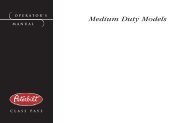Peterbilt Model 320 Operator's Manual after 8-07 - Peterbilt Motors ...
Peterbilt Model 320 Operator's Manual after 8-07 - Peterbilt Motors ...
Peterbilt Model 320 Operator's Manual after 8-07 - Peterbilt Motors ...
You also want an ePaper? Increase the reach of your titles
YUMPU automatically turns print PDFs into web optimized ePapers that Google loves.
PART 7: STARTING & OPERATING THE VEHICLE<br />
Engine Warmup<br />
2. After a few minutes of idling at 600 RPM, increase<br />
your idle speed to 900 or 1000 RPM. Continue your<br />
warmup. This procedure allows oil to warm and flow<br />
freely while pistons, liners, shafts, and bearings expand<br />
slowly and evenly. In extremely cold temperatures,<br />
you may have to increase idle speed.<br />
NOTE: In colder climates where the temperature<br />
is often below freezing, the warmup for<br />
turbocharged engines is especially important.<br />
Chilled external oil lines leading to the turbocharger<br />
will slow the oil flow until the oil<br />
warms, reducing oil available for the bearings.<br />
Watch the engine oil temperature or pressure<br />
gauge for a warming trend before increasing<br />
engine idle speed (RPM).<br />
3. Continue the engine warmup until the coolant temperature<br />
reaches at least 130° F (54° C). At this temperature,<br />
you can use partial throttle. Wait until the coolant<br />
temperature is at least 160° F (71° C) before operating<br />
at full throttle.<br />
WARNING! Exhaust fumes from the engine contain<br />
carbon monoxide, a colorless and odorless<br />
gas. Do not breathe the engine exhaust gas.<br />
A poorly maintained, damaged or corroded exhaust<br />
system can allow carbon monoxide to enter<br />
the cab. Entry of carbon monoxide into the<br />
cab is also possible from other vehicles nearby.<br />
Failure to properly maintain your vehicle could<br />
cause carbon monoxide to enter the cab and<br />
cause serious illness.<br />
CAUTION: Never idle your vehicle for prolonged<br />
periods of time if you sense that exhaust fumes<br />
are entering the cab. Investigate the cause of<br />
the fumes and correct it as soon as possible.<br />
If the vehicle must be driven under these conditions,<br />
drive only with the windows slightly<br />
open. Failure to repair the source of the exhaust<br />
fumes may lead to personal harm.<br />
R(08/<strong>07</strong>) Y53-6015 – 75 –
















